During my August visit to the State Archives in Szczecin, I came across an interesting collection – a file of Masonic lodge members compiled by the Main Security Office of the Reich from 1939 to 1945. In this collection, I found the record of a woman a Jewish woman from Jelenia Góra (Hirschberg), Flora Sachs, who served as the chairwoman of the Sisters Association of the Victoria Lodge.
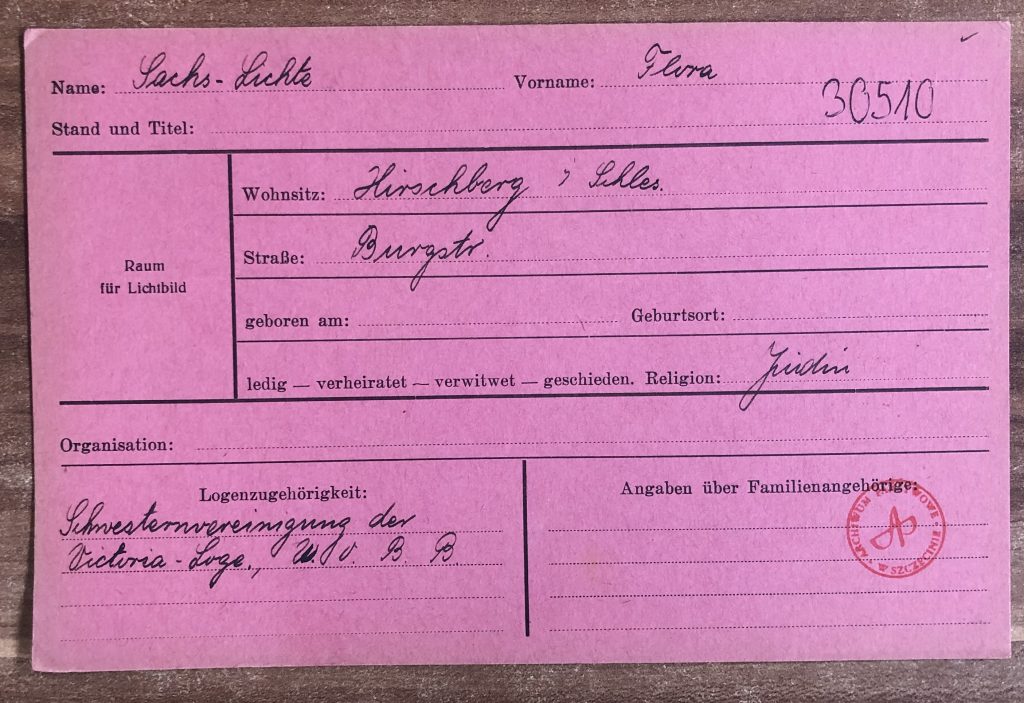
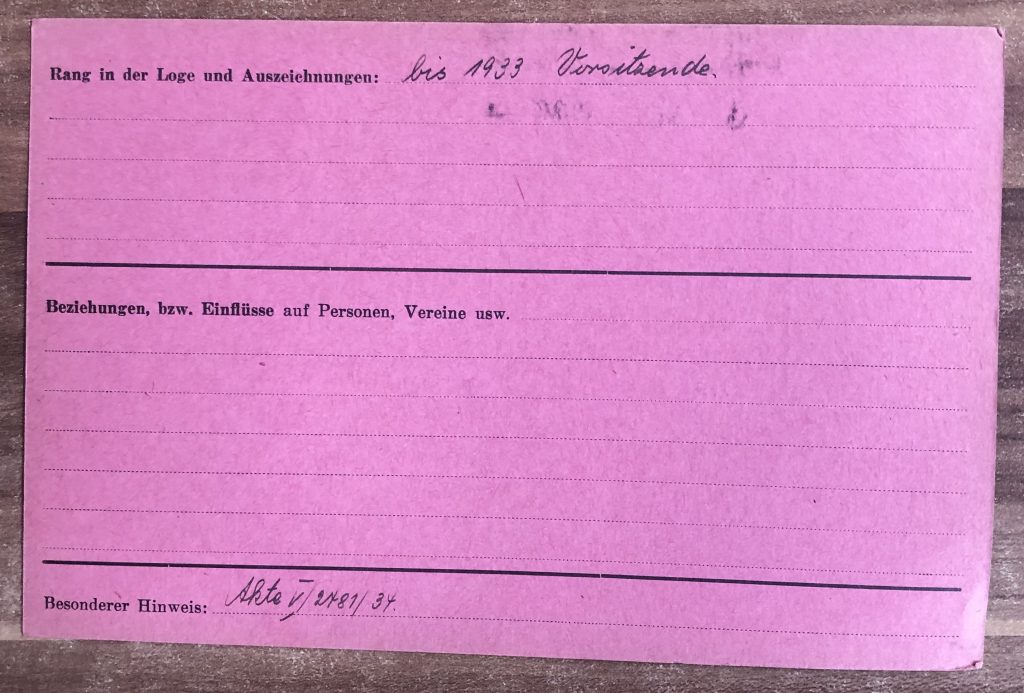
Card of Flora Sachs from the file of Masonic lodge members / Photo: Marta Maćkowiak, State Archives in Szczecin
The main headquarters of Victoria Loge was located in Goerlitz (specifically at Bismarckstrasse 13), and contrary to common belief, its activities did not revolve around esoteric knowledge. Instead, it primarily focused on educating about Judaism and promoting values such as tolerance, goodness, and humanity.
According to the aforementioned card, Flora lived precisely at Lichte Burgstrasse 21 in Hirschberg, which is now Jasna Street in Jelenia Góra.
Parents of Flora Sachs née Nathan – Adolf Nathan and Lina née Cohn / Photos courtesy of Mr. Stephen Anthony Giesswein

Birth certificate of Flora Sachs / Source: Bundesarchiv in Berlin
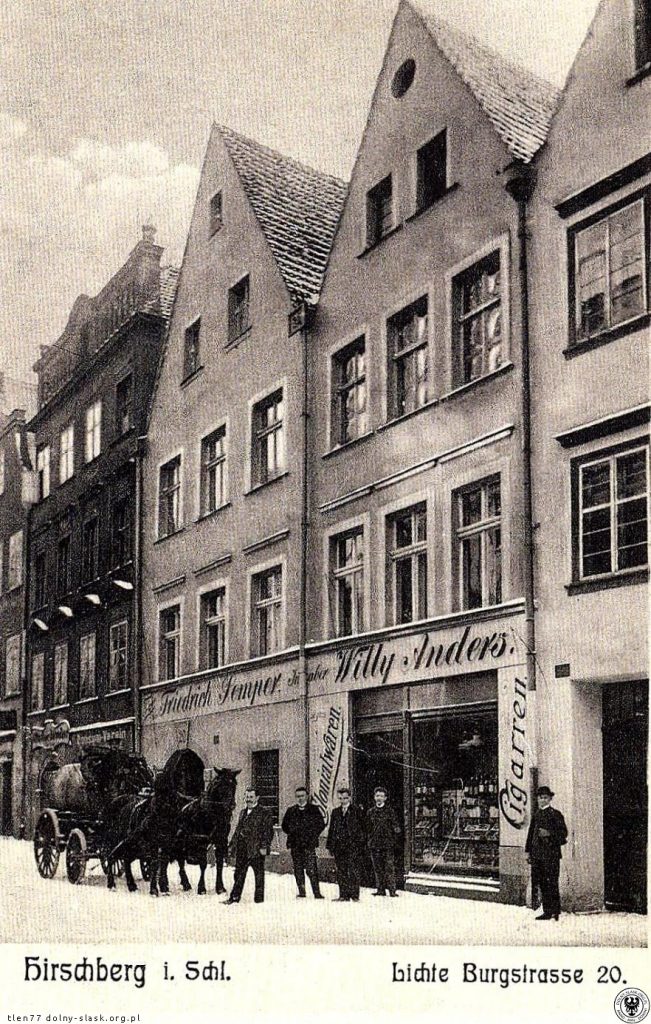
The no longer existing tenements on Lichte Burgstrasse (today’s Jasna Street) in Jelenia Góra / Source: Polska-org.pl
The Sachs family also ran a business here, specializing in tanning leather and trading leather goods, while Simon served as a member of the Jewish community board in Jelenia Góra.
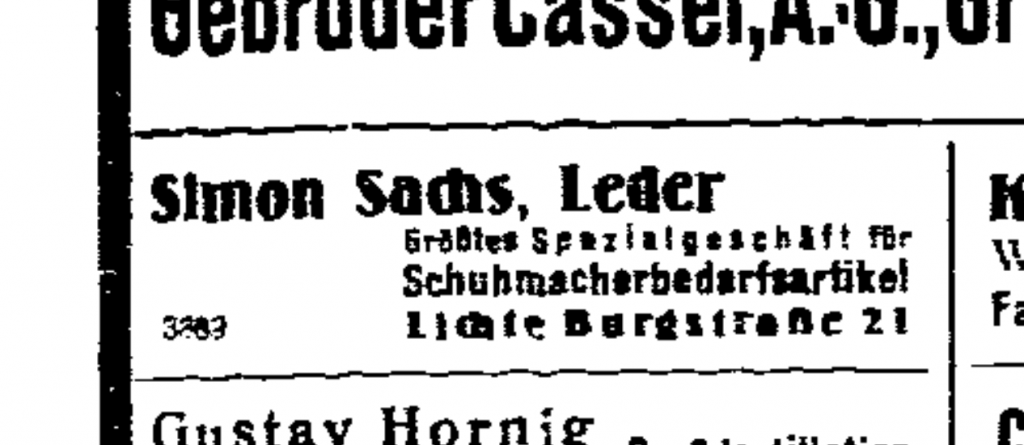
Advertisement of Simon Sachs in the Arbeiter Zeitung, 1931
Cards of Flora and Simon from the Theresienstadt camp.

Statement of Flora’s death posted by her sister / Source: Yad VaShem
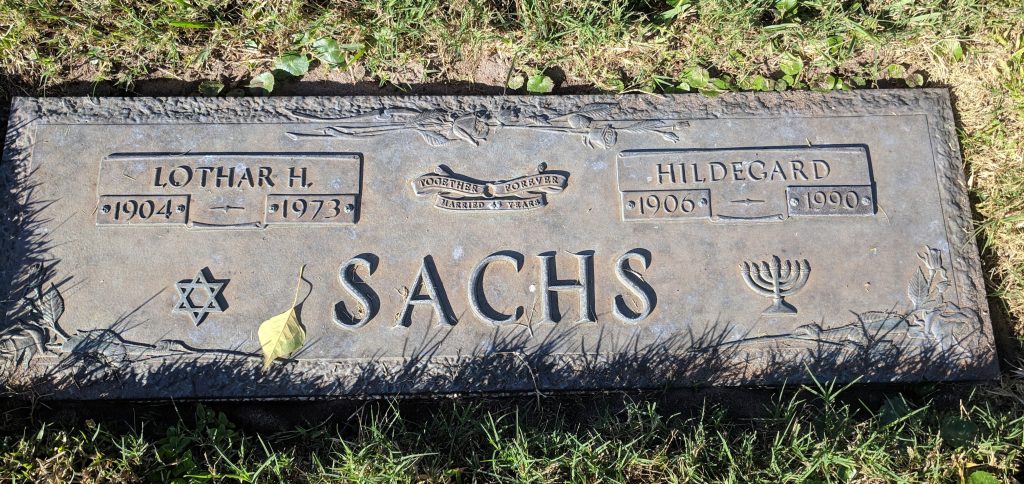

One page of the passenger list featuring Lothar and Hildegarde Sachs. They departed from Hamburg on June 29, 1938.

Statement of intent by Lothar Sachs, son of Flora and Simon, regarding becoming a U.S. citizen.
Sources:
When visiting the state archives in search of specific documents, I like to order ‘random’ folders to see if similar records might come in handy in the future. It’s like a lottery – sometimes I browse through hundreds of boring listings and calculations, and at other times, I discover incredible stories. One of those incredible stories is undoubtedly the story of Anna Drescher.
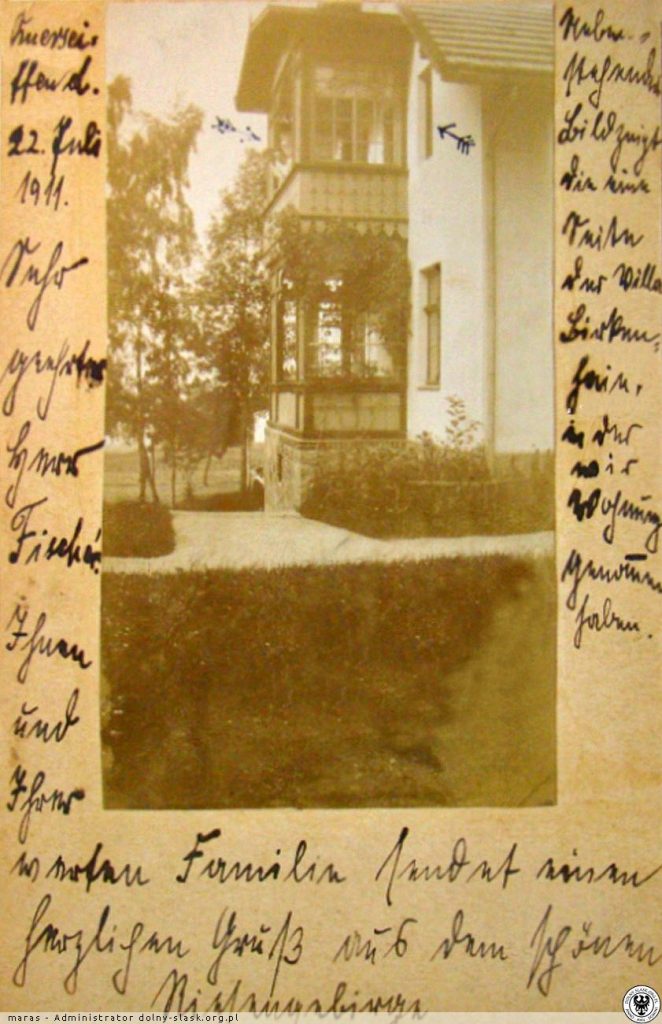
Villa Birkenhain in Krummhübel (presently Brzozowy Sad in Karpacz), ulica Sadowa 2 / źródło: Polska-org.pl
This time, I took on a folder concerning Judenvermögensabgabe, which can be translated as the Jewish Property Tax. Judenvermögensabgabe was a tax introduced on November 12, 1938, and it applied to every German Jew whose property was valued at a minimum of 5,000 marks. This tax was also referred to as the ‘penance tax’ because, after the assassination of the German Embassy Secretary Ernst Eduard vom Rath on November 7, 1938, by Herschel Grynszpan, a Polish-German Jew, Hermann Göring demanded the payment of one billion German marks as ‘penance’ for the damage caused to the German nation by Jews.
While reviewing case after case, my attention was drawn to Anna Drescher, who, in 1938, was residing in Villa Birkenhein in Krummhübel – today’s Brzozowy Gaj guesthouse located in Karpacz at ul. Sadowa 2.
The first page of the folder: “The question of Mrs. Drescher’s Aryan origin has not yet been resolved” – so let’s see what this is about.
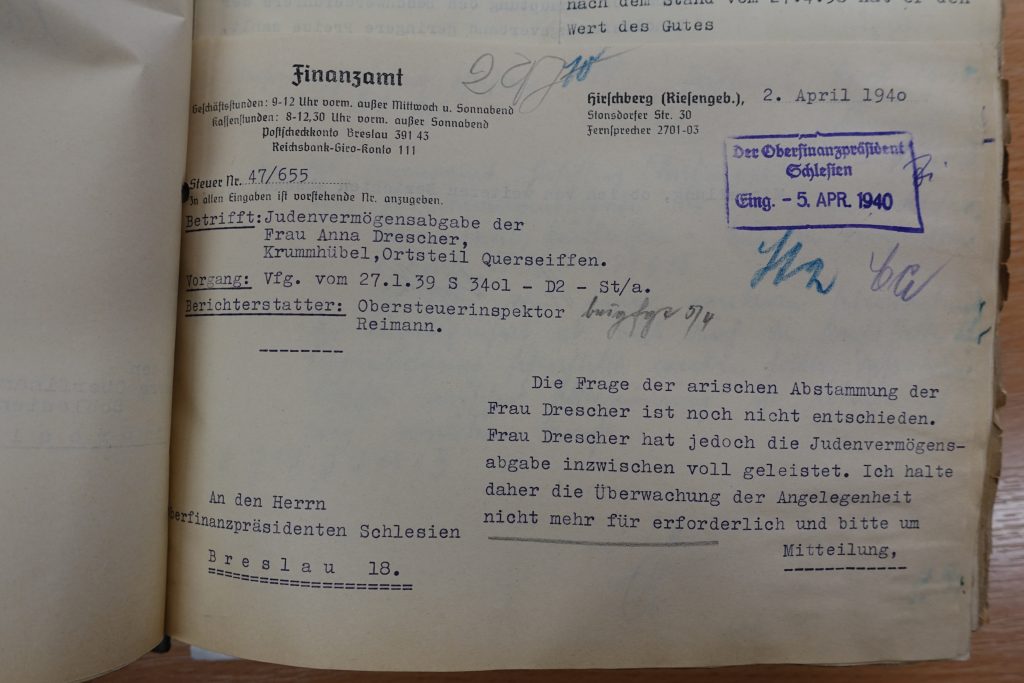
Page regarding Judenvermögensabgabe and Anna Drescher / Source: State Archive in Wrocław
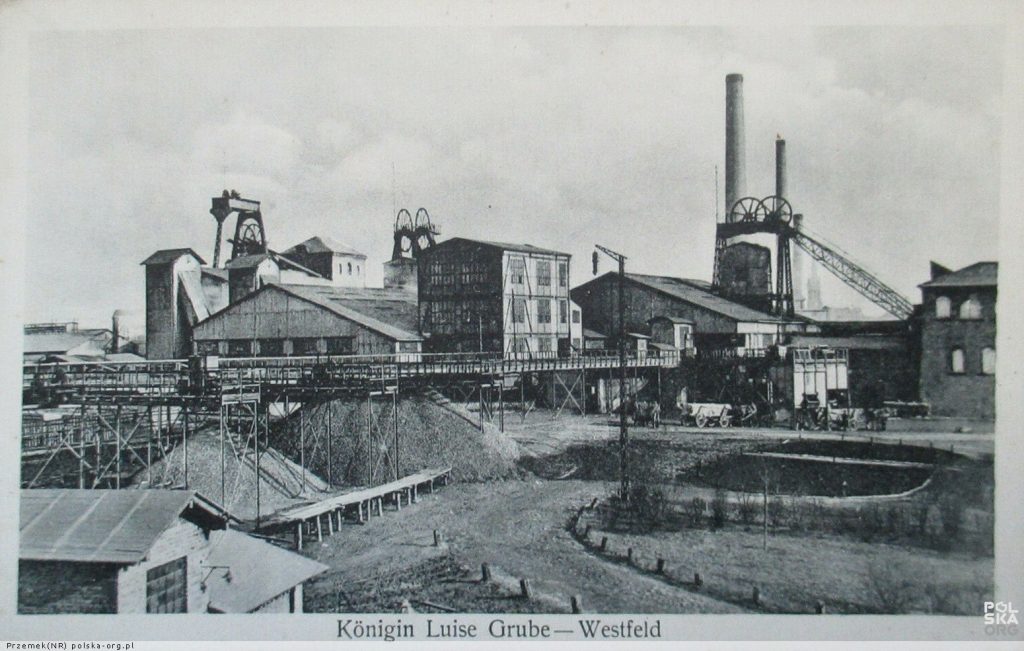
Queen Luiza Mine in Zabrze, 1920s-1930s / Source: Polska-org.pl

Fragment of the birth certificate of Franz Drescher and Anna Toeplitz’s daughter, along with information about their religion / Source: Landesarchiv Berlin
So, Anna Toeplitz was born in Wrocław (Breslau) on April 14, 1879, and was the second of nine children of Dr. Theodor Max and Franziska Toeplitz.
Photographs of Franziska and Theodor Max Toeplitz / Source: Ancestry, Stefan Toeplitz
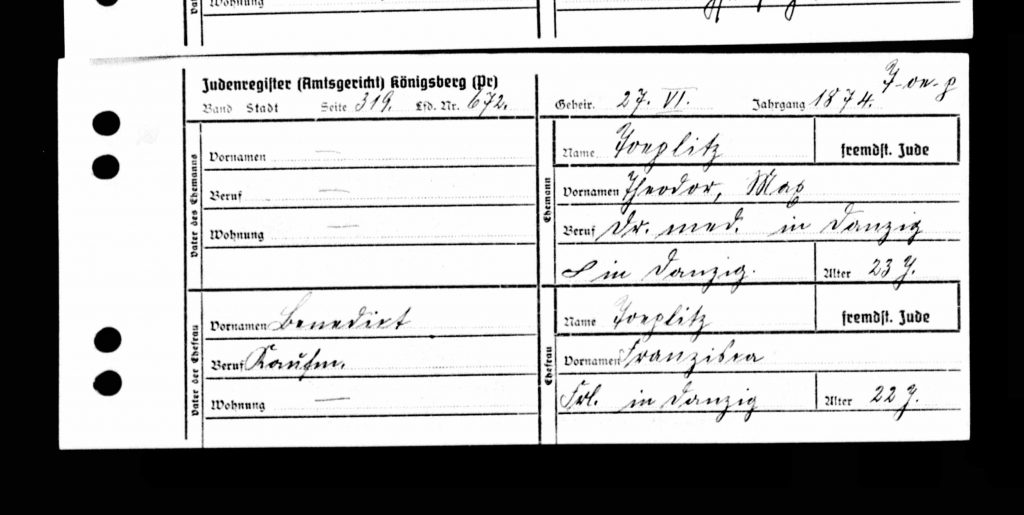
Marriage certificate of Theodor Max and Francizka Toeplitz, Kaliningrad (Königsberg) / Source: Records of the Evangelical Church in Königsberg
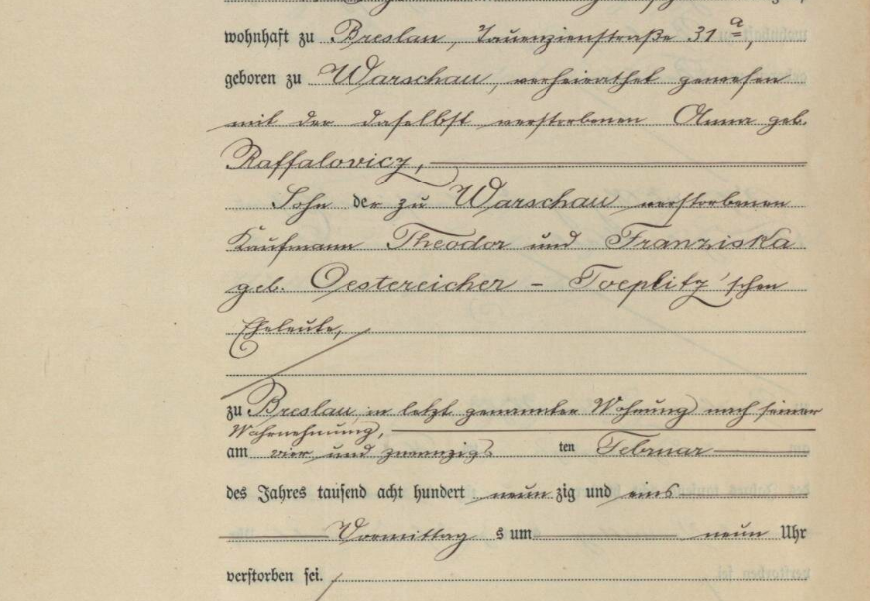
Excerpt from Heinrich Toeplitz’s death certificate / Source: State Archives in Wrocław
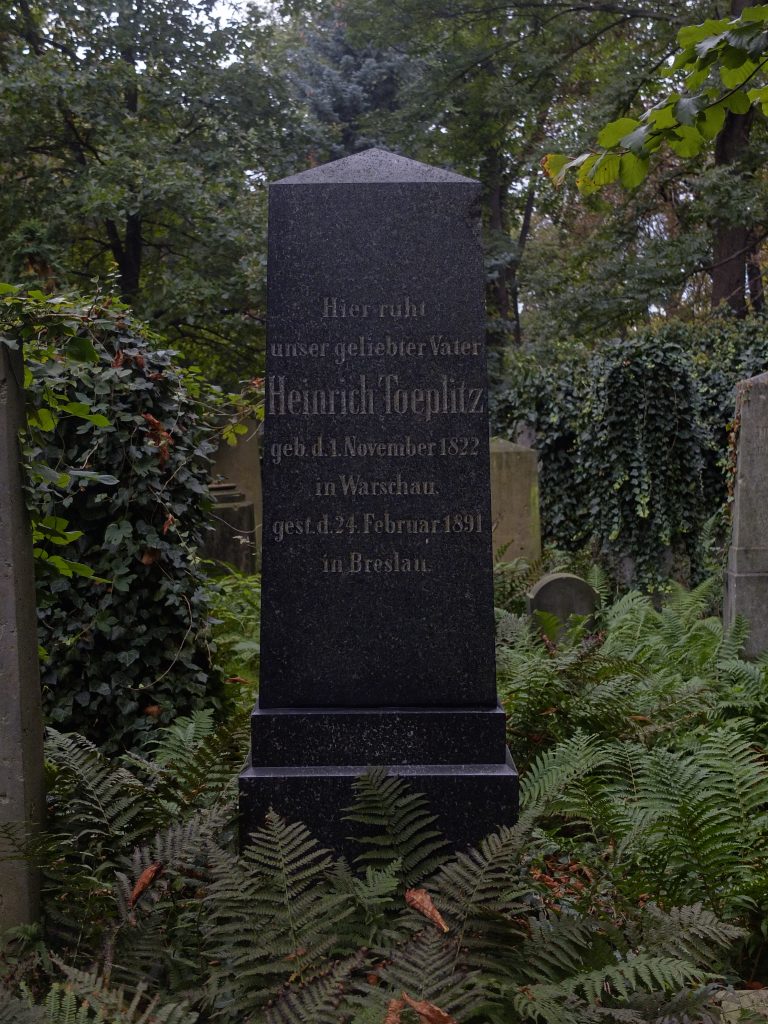
Tombstone of Heinrich Toeplitz at the Old Jewish Cemetery in Wrocław / Photo by Marta Maćkowiak
Returning to our heroine – Anna’s husband, Franz Drescher, passed away in Wrocław on January 20, 1934. Two years later, on October 12, 1936, Anna reported her mother’s death. She was living at Nova Strasse 4 (today’s Ksawery Liske Street) at that time.
At least since December 1938, Anna was residing in Karpacz. In the following years, Nazi officials must have uncovered her Jewish roots because on January 8, 1944, she was sent to the Theresienstadt camp. Fortunately, the story has a happy ending because in 1946, Anna registered with Sharit haPlatah – the Central Committee of Liberated Jews in Bavaria.
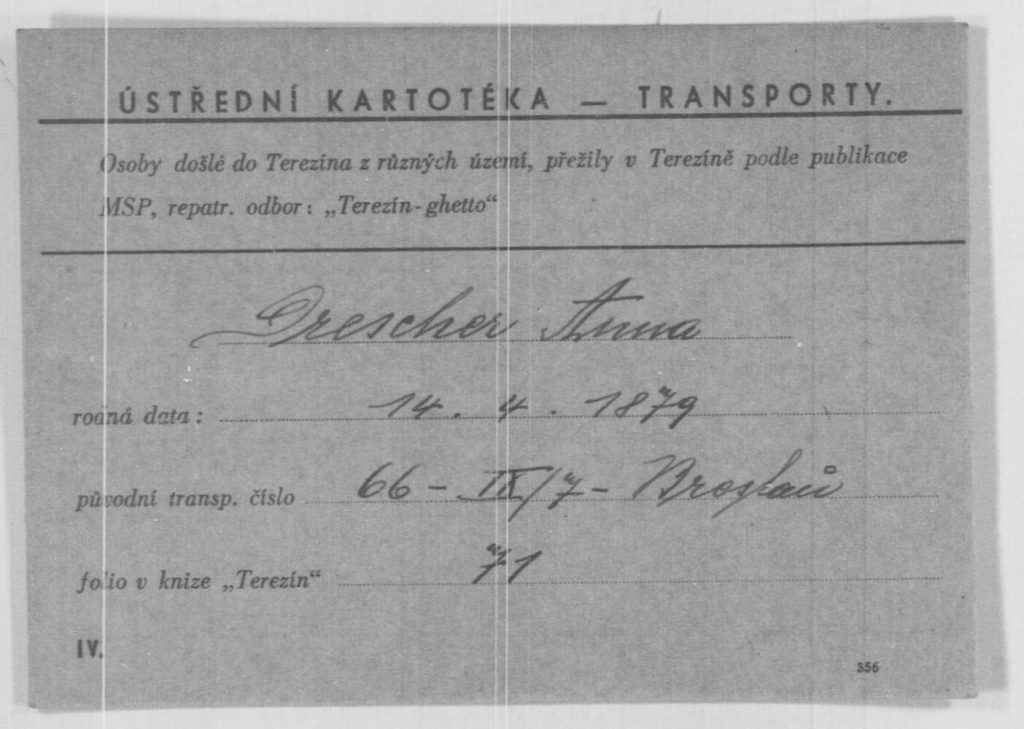
Transport document for Anna Drescher to the Theresienstadt camp (Terezin) / Source: International Tracing Service, Bad Arolsen
Sources:
Do you know that in Nazi Germany, the names Sara and Israel were added to documents for quicker and easier identification of Jews? This was the case, among others, with Laura, on whose marriage certificate I found such an annotation.

Laura Ring née Cohn / Source: Yad Vashem
Laura Ring née Cohn was born on July 6, 1865, into an assimilated Jewish family in Ostrów Wielkopolski. She was the daughter of the merchant Robert Cohn and Taubschen Mamelok.
In 1890, Laura must have been already living in Wrocław, as on January 13 of the same year, she married Josef Ring in the capital of Lower Silesia. Josef, a 24-year-old merchant, was born in Halemba as the son of Julius Ring and Rachel Kosterlitz. He permanently resided in Antonienhütte, now known as Wirek, a district of Ruda Śląska.
After tying the knot, the couple quickly returned to Antonienhütte, where their first child was born. Shortly thereafter, the family made a permanent move to Wrocław, and in 1894, they welcomed a daughter.
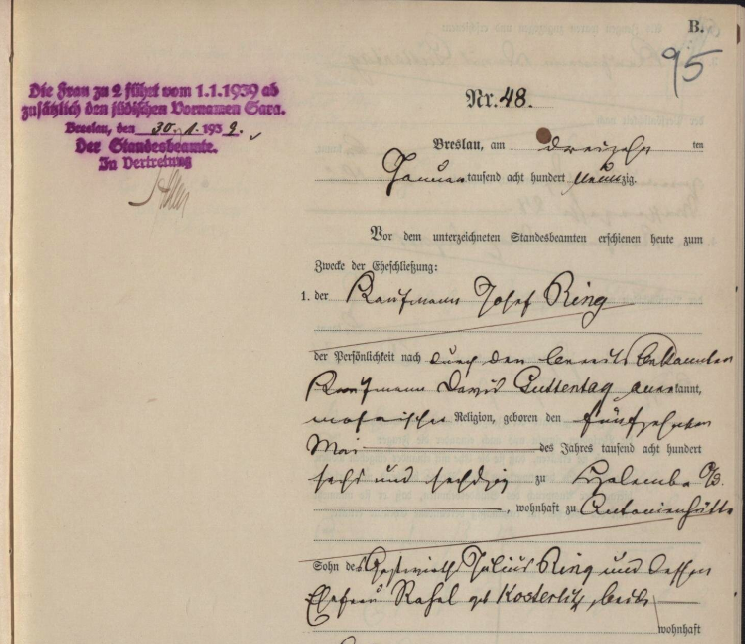
Fragment of Laura Cohn and Josef Ring’s marriage certificate with a note about adopting a second name – Sara / Source: State Archive in Wrocław
On August 27th, 1929, Josef Ring passed away at 6:00 PM at the Allerheiligen Hospital (later Wojewódzki Szpital im. Józefa Babińskiego) at the age of 63. He was buried in the Jewish cemetery on Lotnicza Street (Friedhof Cosel). According to the death certificate, the Ring family resided at Viktoriastrasse 33, today’s Lwowska Street.
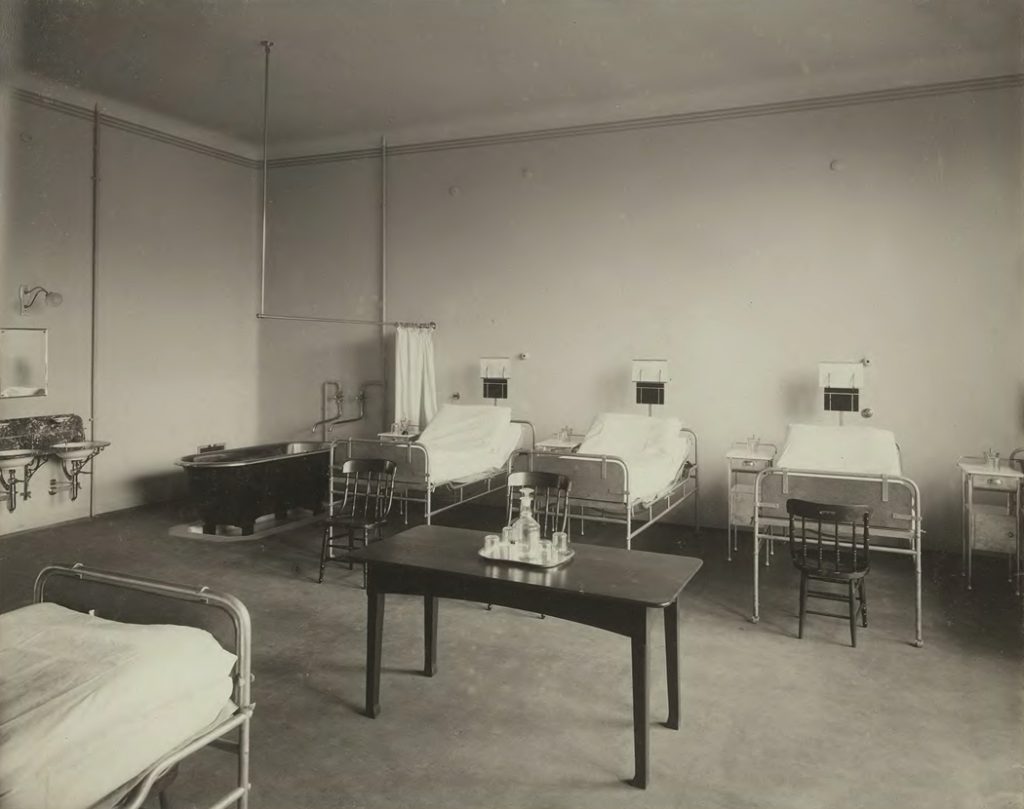
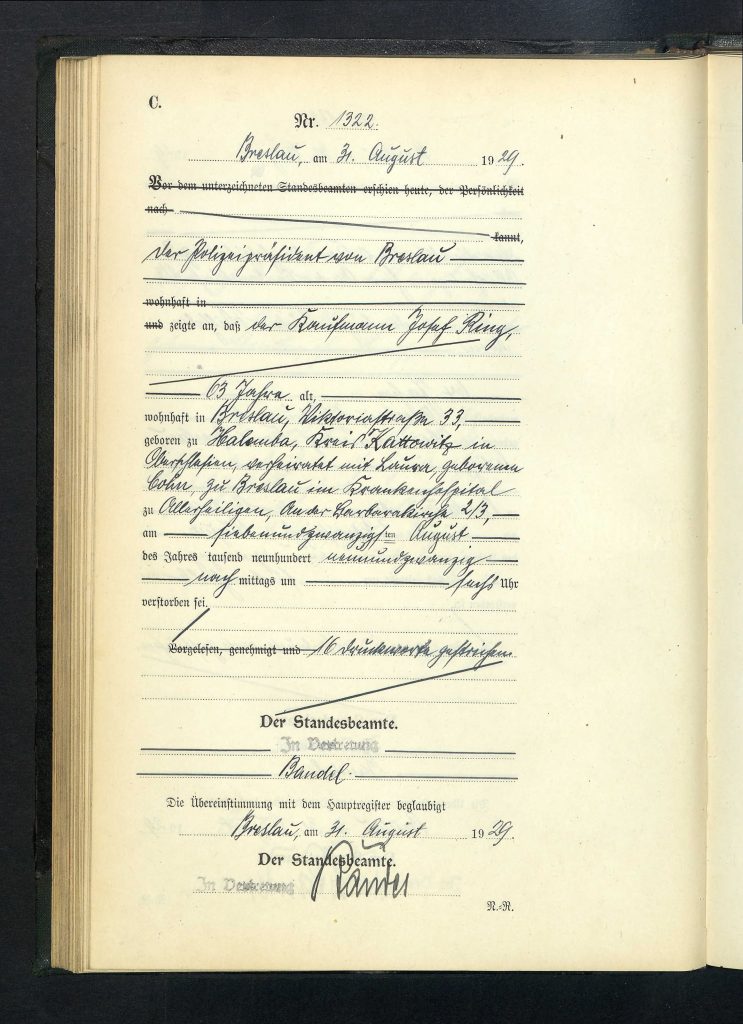
Death certificate of Josef Ring / Source: State Archive in Wrocław
On August 17th, 1938, laws were enacted that mandated the addition of the name Sara for Jewish women and Israel for Jewish men in official documents for German Jews. This was aimed at facilitating the identification of Jewish citizens in the Third Reich.
Such information was also added to the marriage certificate of Laura and Josef on January 30th, 1939.
After Josef’s death, Laura continued to reside at ul. Lwowska 33 until August 31st, 1942, when she was deported to the Theresienstadt camp, where she lost her life.

Address book of the Jewish community in Wrocław from the year 1930 / Source: Jewish Historical Institute in Warsaw
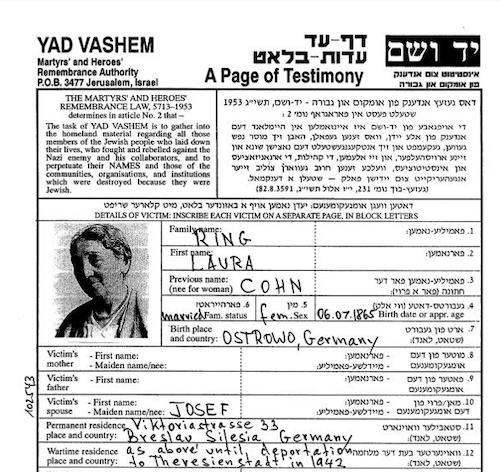
Declaration of the death of Laura Ring née Cohn / Source: Yad Vashem Institute
Sources:
Końcowy raport składa się z kopi odnalezionych dokumentów, tłumaczeń, zdjęć oraz podsumowania. Wyjaśniam pokrewieństwo odnalezionych osób, opisuję sprawdzone źródła i kontekst historyczny. Najczęściej poszukiwania dzielone są na parę etapów i opisuję możliwości kontynuacji.
Czasem konkretny dokument może zostać nie odnaleziony z różnych przyczyn – migracji do innych wiosek/miast w dalszych pokoleniach, ochrzczenia w innej parafii, lukach w księgach, zniszczeń dokumentów w pożarach lub w czasie wojen. Cena końcowa w takiej sytuacji nie ulega zmienia, ponieważ wysiłek włożony w poszukiwania jest taki sam bez względu na rezultat.
Raporty mogą się od siebie mniej lub bardziej różnić w zależności od miejsca, z którego rodzina pochodziła (np. dokumenty z zaboru pruskiego, austriackiego i rosyjskiego różnią się od siebie formą i treścią).
Na podstawie zebranych informacji (Twoich i moich) przygotuję plan i wycenę – jeśli ją zaakceptujesz, po otrzymaniu zaliczki rozpoczynam pracę i informuję o przewidywanym czasie ukończenia usługi. Standardowe poszukiwania trwają około 1 miesiąca, a o wszelkich zmianach będę informować Cię na bieżąco.
Na Twoje zapytanie odpiszę w ciągu 3 dni roboczych i jest to etap bezpłatny. Być może zadam parę dodatkowych pytań, dopytam o cele albo od razu przedstawię propozycję kolejnych kroków.
Warto pamiętać, że im więcej szczegółów podasz, tym więcej rzeczy mogę odkryć.
Podziel się ze mną:
I najważniejsze – jeśli masz niewiele informacji, zupełnie się tym nie martw, w takich sytuacjach także znajdę rozwiązanie.